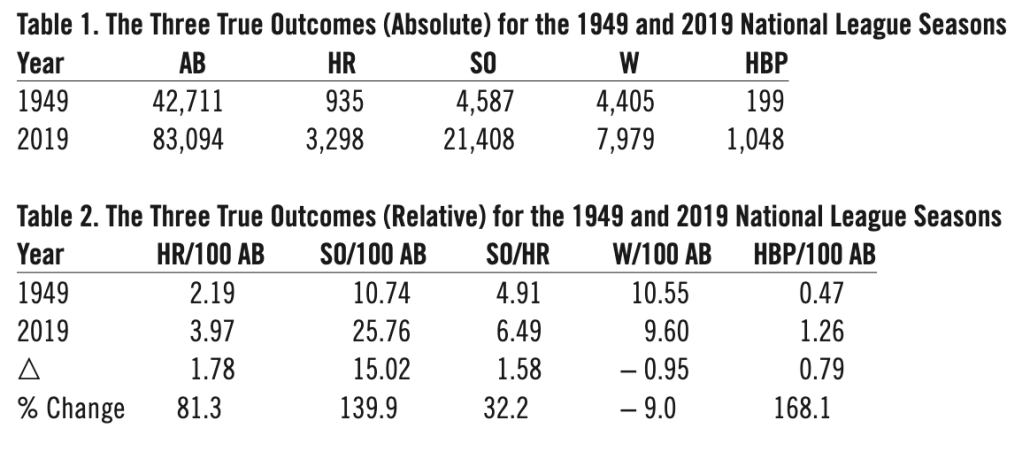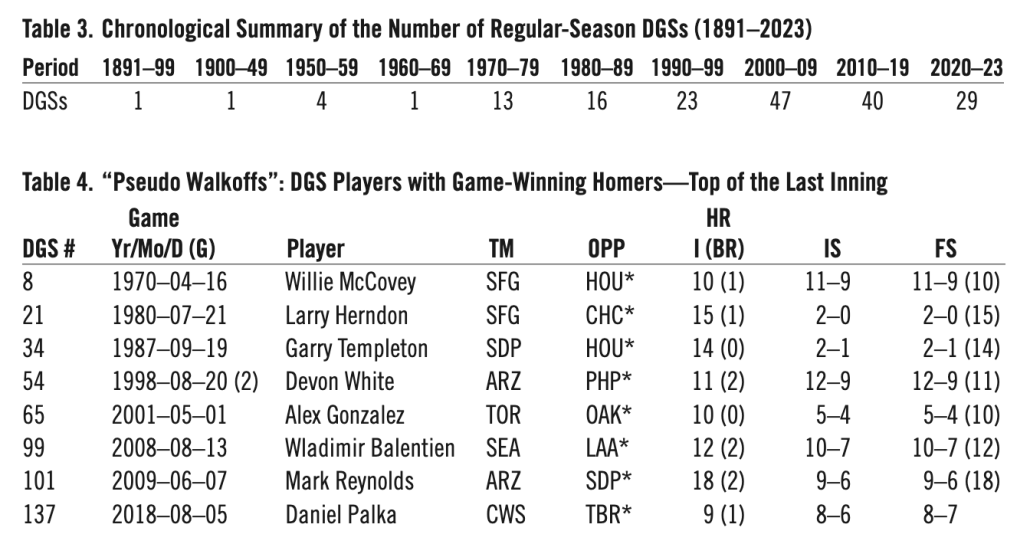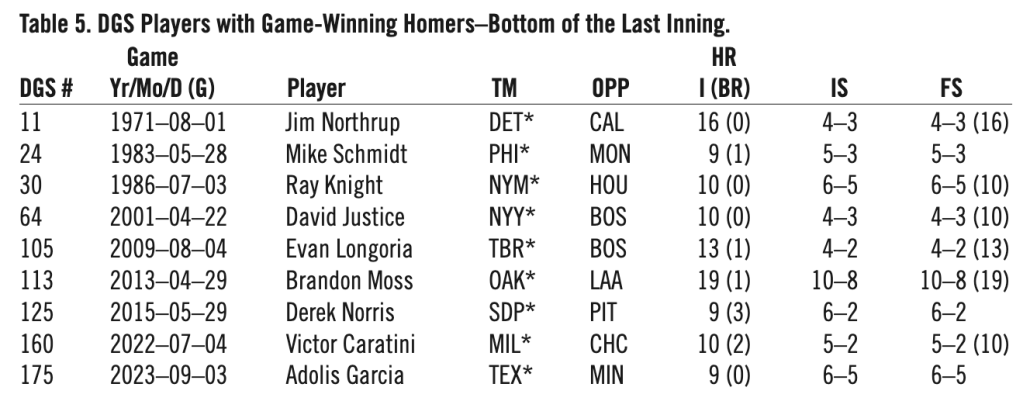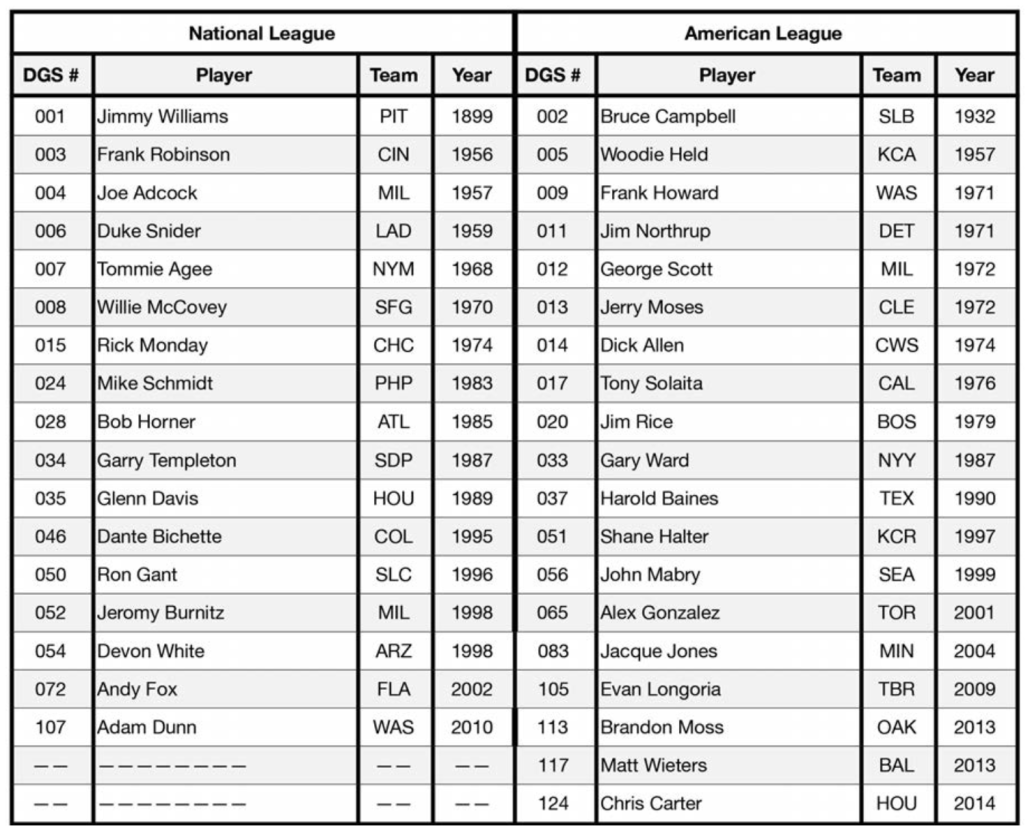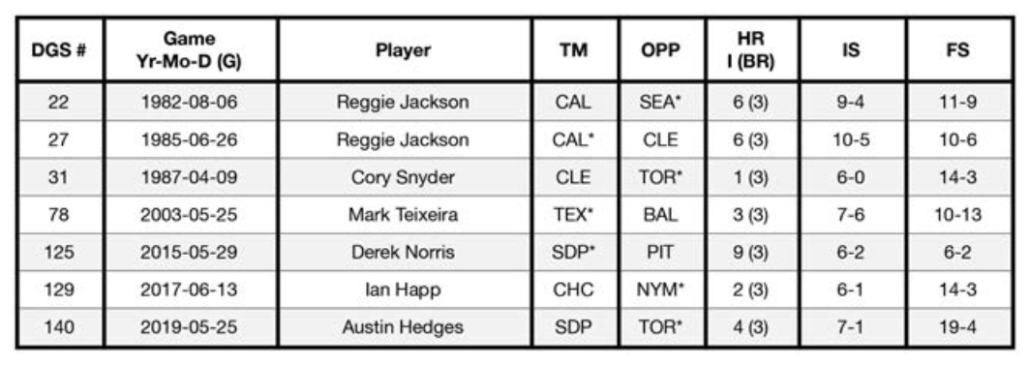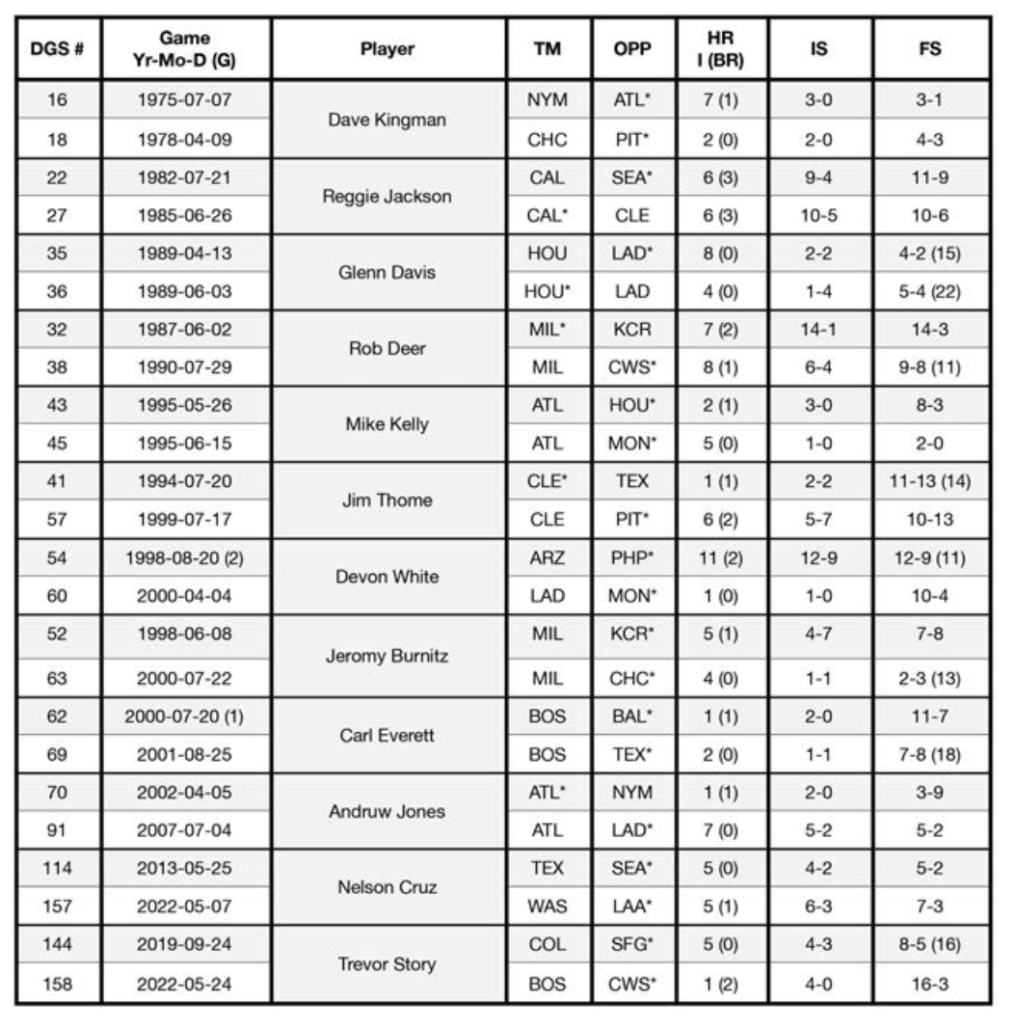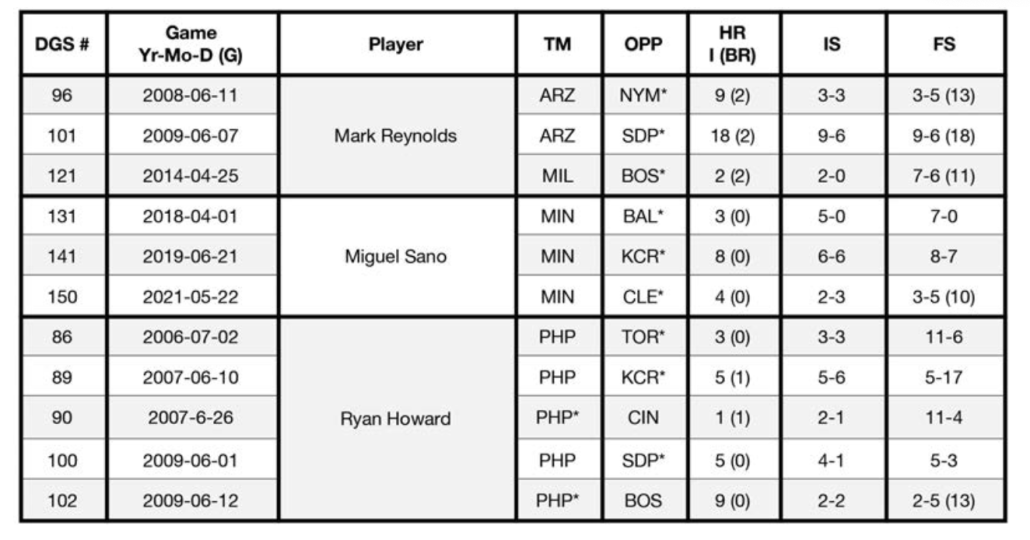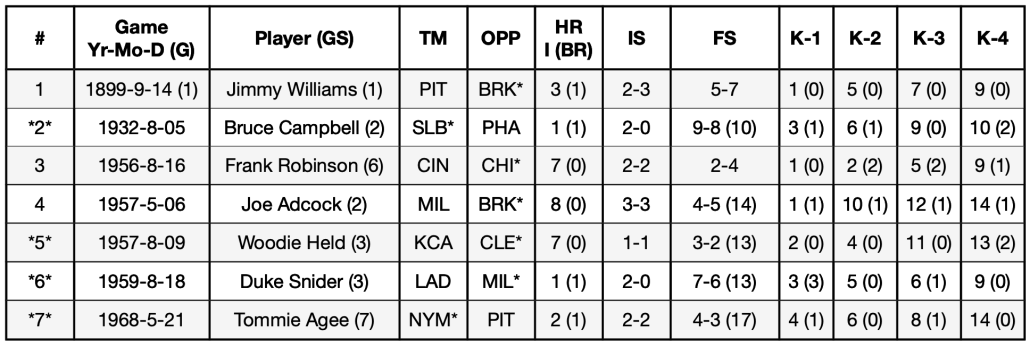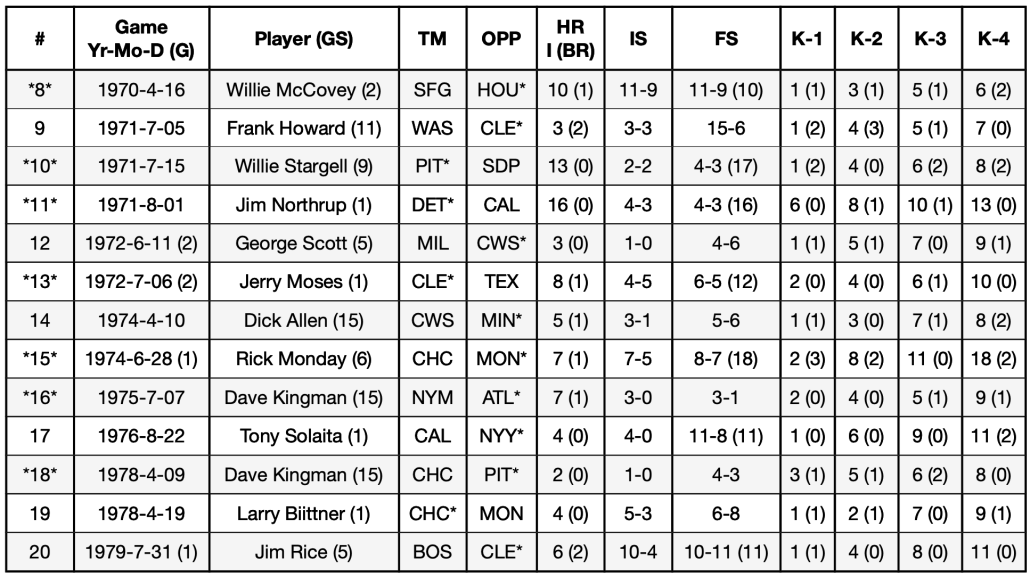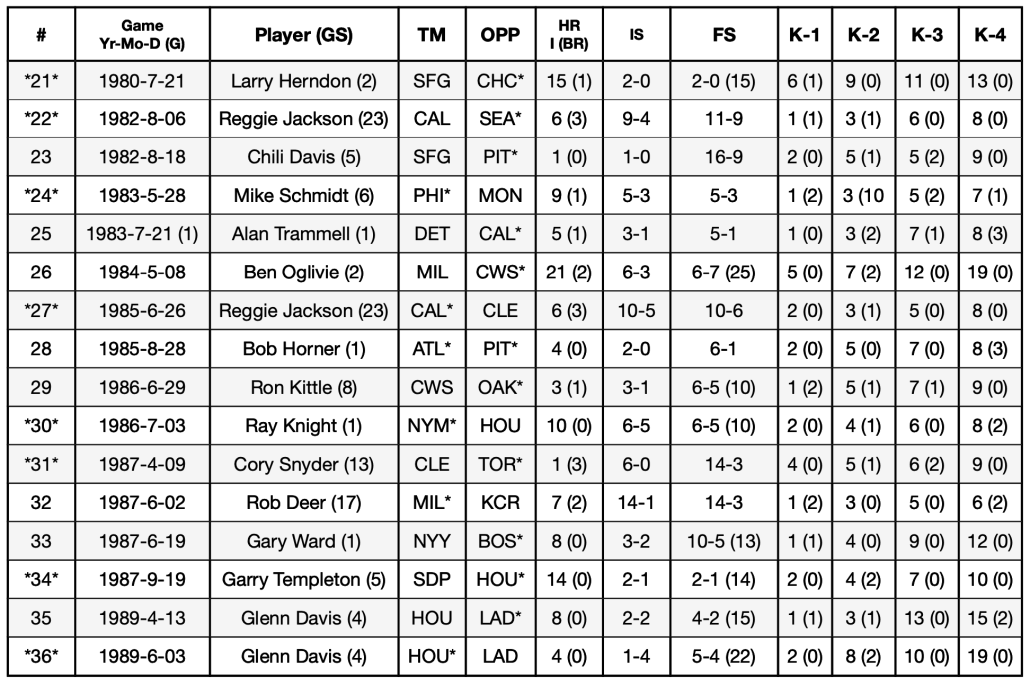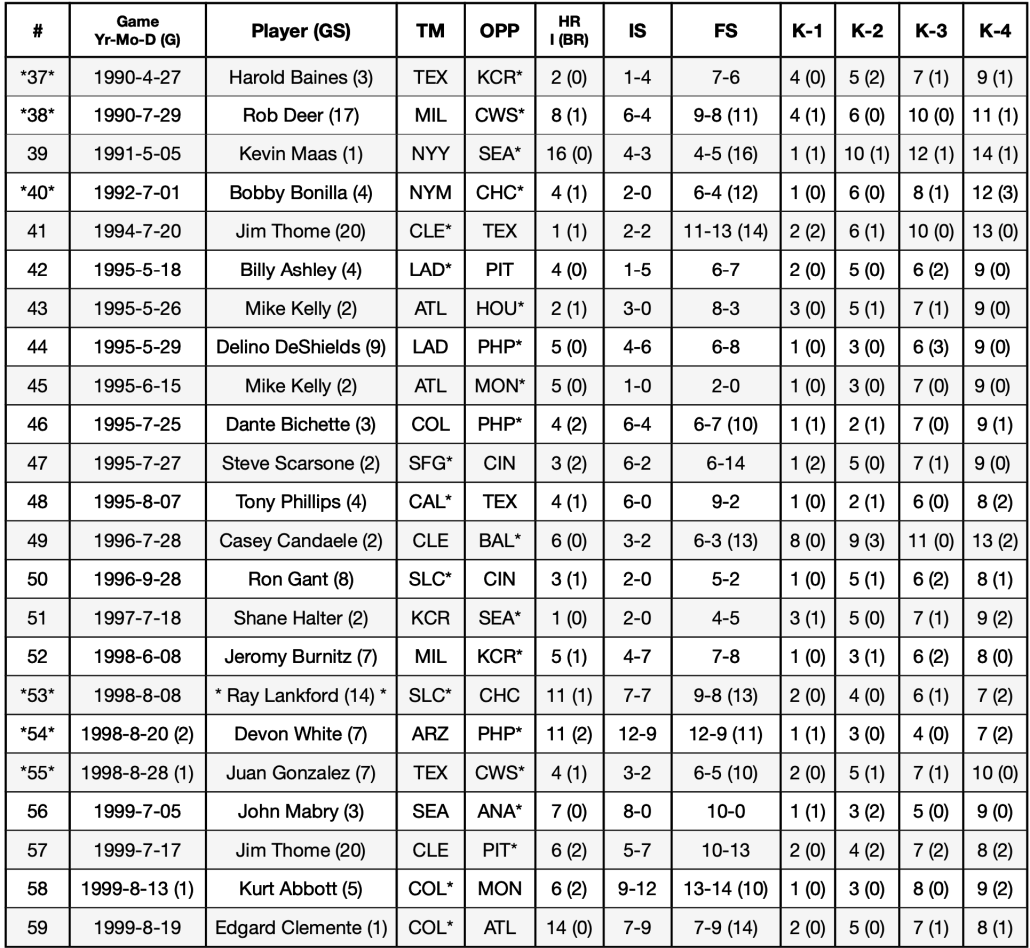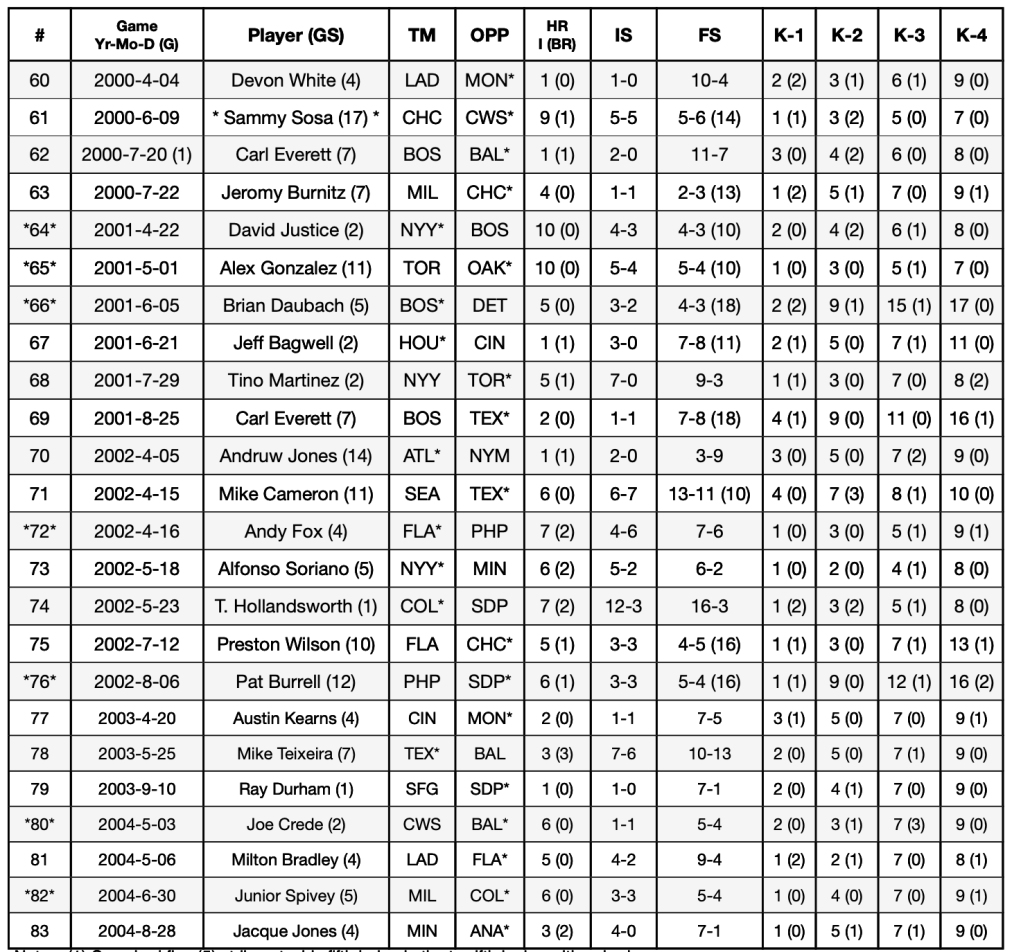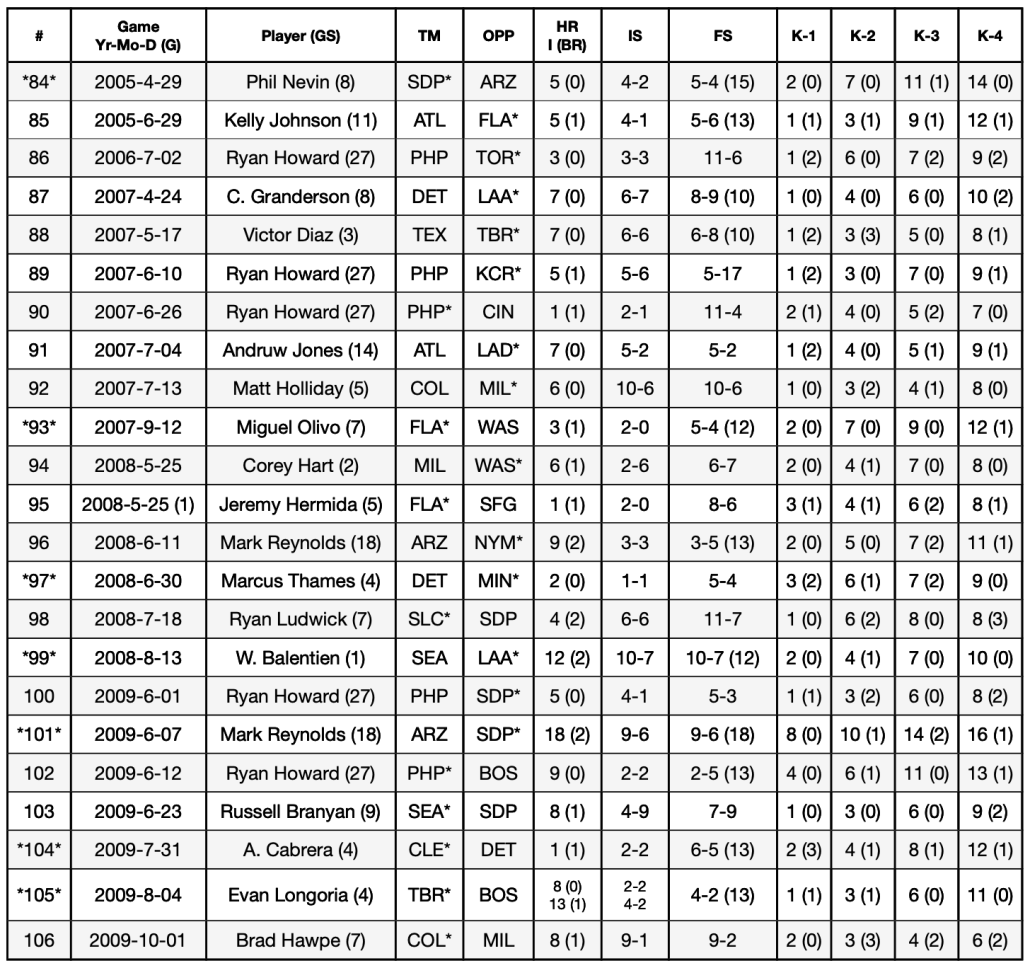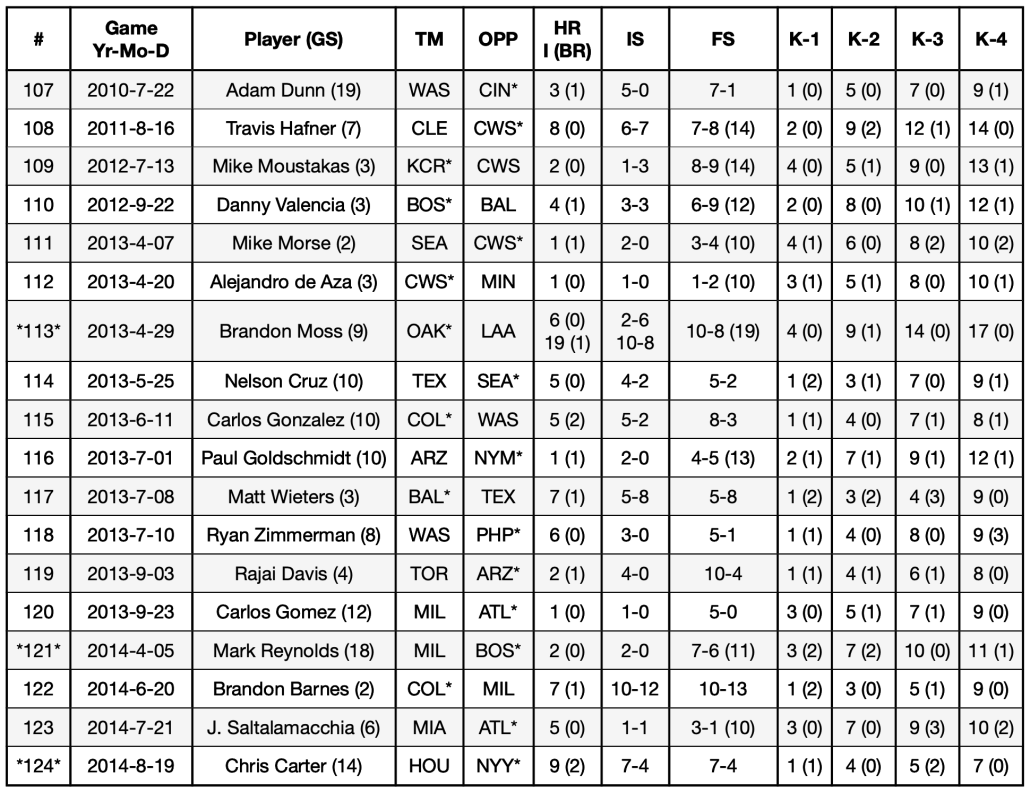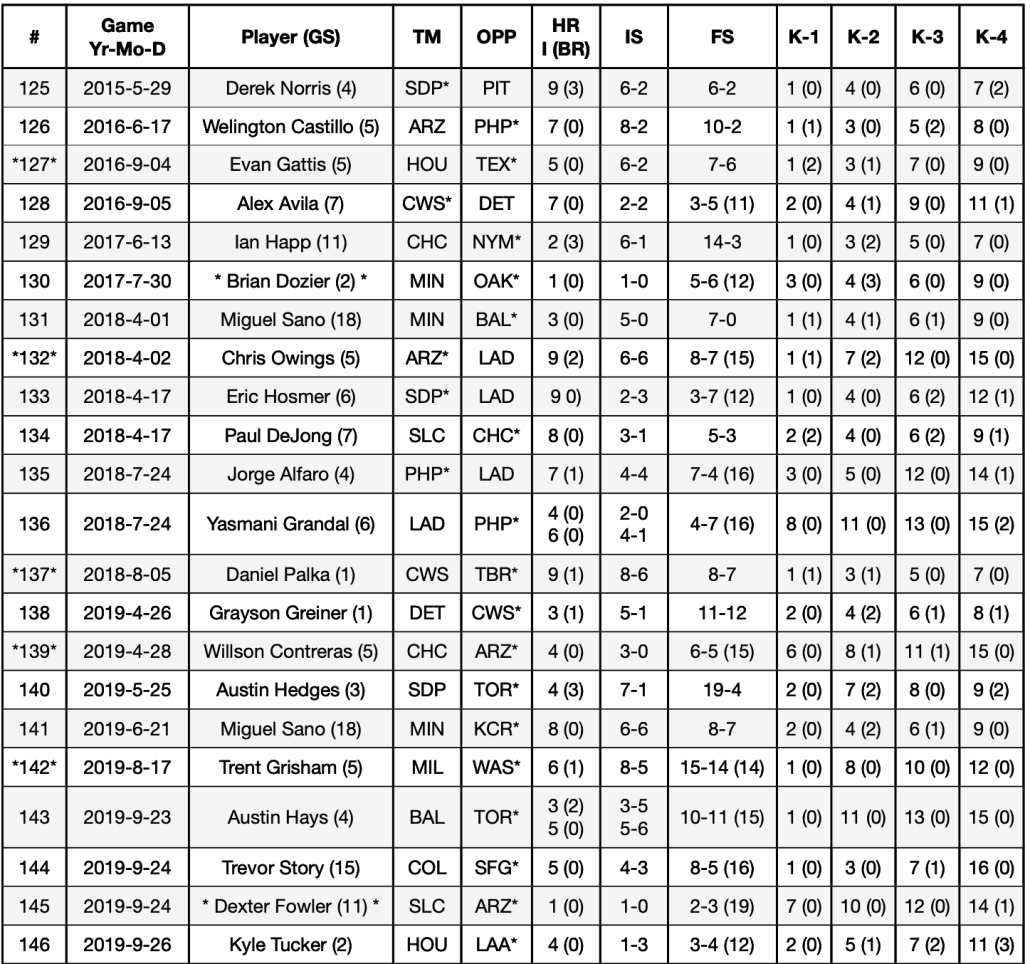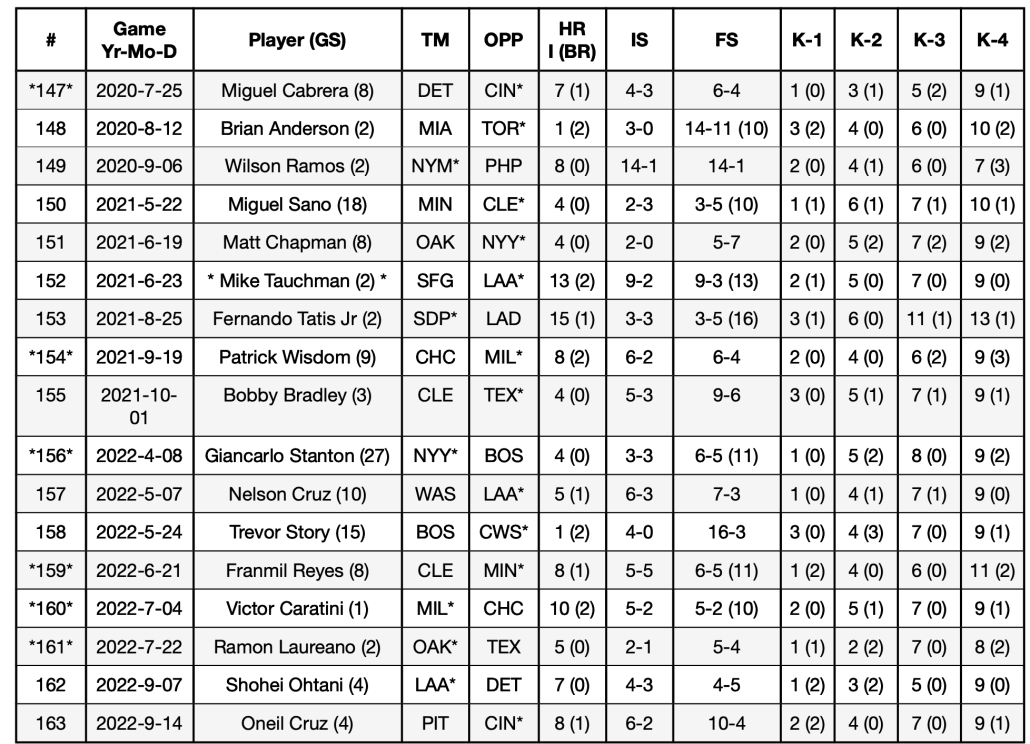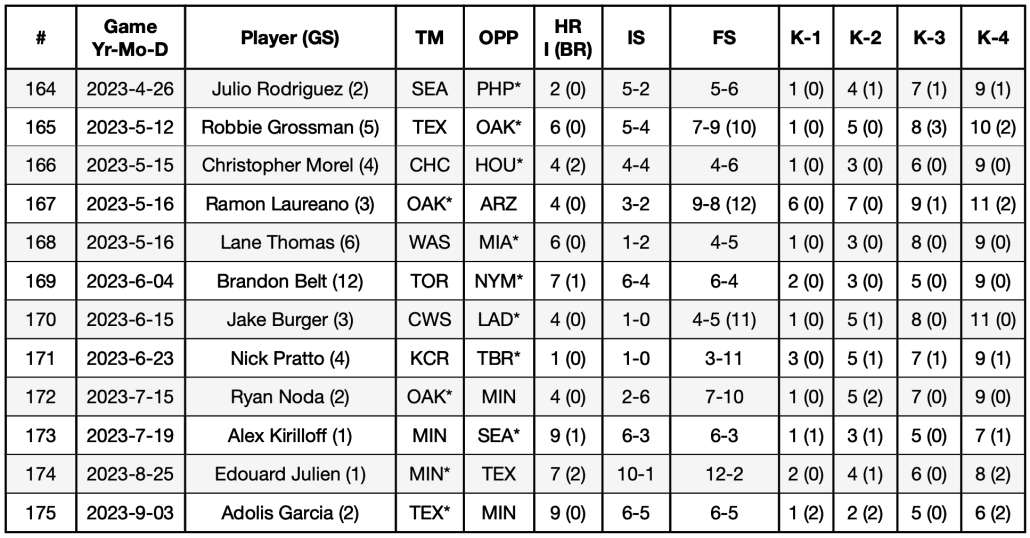Going Downtown with a Golden Sombrero: Combining Baseball’s Best and Worst True Outcomes
This article was written by Herm Krabbenhoft
This article was published in Fall 2023 Baseball Research Journal
For a batter or pitcher, the best—or worst—of the “Three True Outcomes” is a home run or a strikeout.1 The rates of the both home runs and strikeouts have increased substantially over the years. To illustrate, let’s compare 1949 and 2019. In the National League in 1949, 42,711 at bats resulted in 935 homers and 4,587 in strikeouts, while NL batters in 2019 collected 3,298 homers and whiffed 21,408 times.2 Tables 1 and 2 summarize the comparative information (absolute and relative, respectively) for the 1949 and 2019 seasons.3
These data show an 81.3% increase in home runs and a 139.9% increase in strikeouts from 1949 to 2019. The rate of strikeouts per homer is also up substantially: 32.2%.
Turning the focus to specific players, I thought it would be interesting to see which players have compensated for multiple strikeouts in a game by hitting a key home run. In the baseball lexicon one term seems particularly appropriate—the “Golden Sombrero,” which, according to The Dickson Baseball Dictionary, is “A mythical award given to a batter who strikes out four times in a game.”4 And since “Going Downtown” is a commonly used expression to describe hitting a home run, I’ve dubbed the combination of four strikeouts and a homer in the same game a Downtown Golden Sombrero (DGS). My research here has two objectives: First, find all players with a Downtown Golden Sombrero.5 Second, find out were any of those downtowners redemptive—i.e., a game-winning or a game-saving homer?
RESEARCH PROCEDURE
Using the Stathead search engine on the Baseball-Reference.com website, I ascertained all players who assembled (I hesitate to use the term “achieved”) a Golden Sombrero and also went Downtown in the same game, during the regular seasons from 1901 through 2023 in the American League and National League seasons, and in 1914–15 in the Federal League. I also searched the Game-By-Game statistics generated by Information Concepts, Incorporated (ICI sheets) for the 1891–1900 National League seasons.6 A complete list (with the pertinent details) of all the DGSs found is provided in the Appendix to this article, available below. Using these lists of DGSs, I then examined the Play-By-Play (PBP) files on the Baseball-Reference and Retrosheet websites as well as the game descriptions presented in relevant newspapers to obtain the critical details of the game.
RESULTS
According to my research, there were 175 DGS performances in the regular season—including five times when the player merited the “Downtown Platinum Sombrero” (the player struck out five times). There have also been four DGSs in postseason play. Table 3 presents a chronological breakdown by decade of regular-season DGSs 1891–2023.
After a paltry seven DGSs during the 79 seasons from 1891 through 1969, the number of DGSs has increased dramatically in the 54 seasons since 1970—168 more. The twenty-first century has been extraordinarily explosive—112 DGSs in just 23 seasons. And there have already been 29 DGSs in the first four seasons of the 2020s decade (including the pandemic-abbreviated 2020 campaign of only 60 games).
While the main focus of my research effort was to identify the DGS awardees who came through with game-clinching downtowners, I also uncovered a number of other interesting notes. Accordingly, the following topics are presented in the Appendix below:
- (A-1) The first DGS for each NL and AL franchise
- (A-2) DGS grand slams
- (A-3) Players with multiple DGS games
- (A-4) Players with multiple-homer DGS games
- (A-5) Players who led off with a homer
- (A-6) Downtown Platinum Sombrero awardees
- (A-7) Postseason DGSs
There are two types of last-inning game-winning homer, the “pseudo” walk-offs (hit in the top of the inning) and the “bonafide” walk-offs. For a pseudo walk-off homers, the lead produced by the downtowner has to be protected in the bottom half of the frame. As it has turned out, there have been eight DGSs featuring pseudo walk-offs and nine DGSs with bonafide walk-offs. The 17 DGS players who achieved these phoenix-like performances are highlighted in this article (see Tables 4 and 5).7
(Click image to enlarge)
A. THE DGS PLAYERS WITH PSEUDO WALK-OFF DOWNTOWNERS
Willie McCovey of the 1970 San Francisco Giants was the first player to come through with a game-winning downtowner after striking out in four prior at bats. In the game on April 16 against the Astros in Houston, Stretch was K’d in his first four plate appearances—Jim Bouton got him in the first, third, and fifth, while Jack Billingham fanned him in the sixth. In the eighth, Willie Mac drew a base on balls from Fred Gladding. In the top of the tenth, with the game tied, 9–9, McCovey stepped into the batter’s box with Bobby Bonds on third base and two outs. Houston skipper, Harry “The Hat” Walker, made a pitching change from right-hander Dan Osinski to southpaw Jack DiLauro. On DiLauro’s second pitch, McCovey drove the ball downtown, giving the Giants an 11–9 lead, which San-Fran reliever Ron Bryant protected by setting down the Astros 1–2–3 in the bottom of the frame.8
Larry Herndon clouted his phoenix-like downtowner on July 22, 1980. The game-winning blast came in the 15th inning of the game that had started the day before, on July 21, in the Windy City. After having grounded out in his first two trips to the plate, Herndon was struck out by Cubs starter Rick Reuschel in the sixth. In the ninth, Bruce Sutter struck him out. And in the eleventh, Dick Tidrow sent him back to the dugout via the strikeout. The game, still scoreless, was suspended after the twelfth inning and resumed the next day. Facing Bill Caudell in the thirteenth, Herndon struck out to merit the Golden Sombrero. Redemption, however, came in the fifteenth—with one man on and one man out, Herndon took Caudill downtown to give the Giants a 2–0 lead. San Francisco reliever Gary Lavelle gave up a leadoff single in the bottom of the 15th, but then set down the next three batters to secure the win.
Garry Templeton was playing for the San Diego Padres in a game against the Astros in Houston. He had struck out three times against starting pitcher Nolan Ryan and once against reliever Larry Anderson. He also grounded out in the twelfth while facing Rocky Childress. Then, in the top of the 14th, with the game still knotted, 1–1, with two down and the bases empty, Templeton went downtown to give the Padres a 2–1 advantage. San Diego’s mound corps of Dave Leiper and Lance McCullers preserved the victory (despite giving up a couple of hits). After the game, San Diego skipper Larry Bowa was exuberant about Templeton’s downtowner, exclaiming, “Templeton called that home run; can you believe it? He was running around the dugout telling everybody he was going to leave the yard; leave the yard! Told about five people. Can you believe it?” When told what Bowa had said, Templeton replied, “What? I’d have to be some kind of stupid to call my own shot. Especially in this ballpark. All I told everybody was, ‘I’m going to hit the ball hard.’ Maybe it just sounded like ‘yard.’”9
Devon White earned two DGS awards in his big-league career, the first one coming with Arizona in 1998. After not playing at all in the first game of the August 20 twin-bill in Philadelphia, White had “two different games” in the second game of the double header. In his “first game,” White struck out in each of his four at bats—two swinging Ks versus starter Ken Ryan and two looking versus Jerry Spradlin and Yorkis Perez, one each. Then, in his “second game,” with the Diamondbacks trailing by a 4–9 score going into the top of the eighth, White rose from the ashes, hitting a 2-RBI single off Wayne Gomes to make the score 8–9, and then coming around to tally the run that knotted the score, 9–9. After being stranded following a leadoff double off Ricky Bottalico in the tenth, he came to bat in the eleventh with two outs and runners on first and second. Bottalico was still on the hill. The count went to 1 ball, 2 strikes. Instead of becoming a five-time K-victim, White connected for a homer “on a hanging breaking ball which barely cleared the fence in front of the Phillies bullpen.” With a 12–9 lead, D-Backs reliever Alan Embree then held the Phillies scoreless in the bottom of the inning to secure the victory. After his phoenix-like game, White said, “I can’t explain it. I just put the first couple of at bats out of my mind. You can’t think about it; that’s the stuff that wears you down. You keep battling.”10
Alex Gonzalez was baffled by an assortment of breaking pitches, striking out swinging four times in the May 1, 2001, game against the Oakland A’s. The Blue Jays shortstop was victimized three times by forkballer Cory Lidle and once by reliever Jim Mecir. With the game tied, 3–3, in the top of the tenth, Gonzalez stepped in to face Jason Isringhausen. He homered on Isringhausen’s first pitch to give Toronto a 5–4 advantage, which the Toronto bullpen protected in the bottom of the tenth. Here’s what Gonzalez said about his DGS game: “That forkball was giving me trouble tonight. When Isringhausen came in, I knew he has a good fastball, but the forkball isn’t a pitch he has. I was able to put that forkball out of my mind and swing hard.”11
Wladimir Balentien of the Seattle Mariners struck out in his first three at bats against Angels starter Ervin Santana on August 13, 2008. After grounding out in his fourth trip to the plate, he took a called third strike from Darren Oliver in the 10th. Then, in the top of the twelfth, with two down and runners on first and third, he powered a 1–1 pitch from Justin Speier into the seats in deep center field for a home run, giving the M’s a 10–7 lead, which Roy Corcoran converted into a win by tossing a perfect bottom of the 12th.
Mark Reynolds collected three DGSs in his major-league career, his second coming in 2009 with the Diamondbacks, in an 18-inning game in San Diego on June 7. He had face-to-face encounters with seven pitchers … and one infielder. In his first two plate appearances he grounded out (in the 2nd) and drew a base on balls (in the 5th) versus Padres starting pitcher Josh Geer. He also received a free pass (in the 6th) from reliever Joe Thatcher. Then he struck out swinging in his next two trips to the batter’s box, against Cla Meredith (in the 8th) and Heath Bell (in the 10th). In the 12th, with the game still deadlocked, 6–6, Edward Mujica retired him on a flyout. It was back to the swing-and-miss strikeouts again in the 14th (by Luke Gregerson) and 16th (by Chad Gaudin). With San Diego having gone through nine pitchers, manager Bud Black selected infielder Josh Wilson to start the 18th inning. [Wilson had entered the game in the 12th inning in a double-switch.] Wilson—who actually had begun the 2009 season as Reynolds’ teammate on the Diamondbacks before being claimed on waivers by the Padres on May 15—proceeded to retire two D-Backs while giving up a hit and issuing a walk before facing Reynolds. Wilson quickly got Reynolds in an 0–2 hole. But Reynolds managed to work the count full. On the eighth pitch, Reynolds took Wilson downtown, giving Arizona a 9–6 lead, which Leo Rosales saved with a perfect bottom half. After the marathon, Reynolds said, “It’s tough because No. 1, he’s a position player and you don’t want him to get you out, and No. 2, you don’t know what he’s going to throw.” That said, Reynolds did have a small clue: “When he pitched for us [one inning to mop-up a game on May 11] he threw all fastballs, so you figure he has some kind of wrinkle. He threw a curveball up there and I laid off some high fastballs; he left one out over and I was able to barrel it up.”12
Daniel Palka of the 2018 White Sox achieved the most-recent DGS featuring a pseudo walk-off downtowner. In the August 5 game against the Rays, he had struck out swinging in each of his first four at bats—against opener Hunter Wood in the first and bulk-reliever Ryan Yarborough in the third, fifth, and seventh innings. In the top of the ninth, with the game tied, 6–6, he stepped in the batter’s box with two outs and a runner on first to face Diego Castilla, the Rays’ third pitcher of the game. On the first pitch, Palka drove a fly ball deep into the center field stands, giving the ChiSox an 8–6 advantage. Although the bullpen surrendered a run in the bottom of the stanza, Chicago still emerged with the 8–7 triumph. The Chicago Tribune reported, “Palka’s 439-foot bomb came in the ninth, after which he said, ‘I just had to forget the first eight-ninths of the game and move on from there.”13
B. THE DGS PLAYERS WITH BONAFIDE WALK-OFF DOWNTOWNERS
Jim Northrup of the 1971 Detroit Tigers was the first player to manufacture a bonafide walk-off downtown golden sombrero. In the August 1 contest with the visiting Angels, Northrup had gone hitless in his first six trips to the plate—after groundball outs in the first and third, Northrup struck out swinging in his next four at bats, against Dave LaRoche (sixth), Eddie Fisher (eighth), and Lloyd Allen (10th and 13th). In the bottom of the 16th, with the score knotted at 3–3 and one out, Northrup again squared off against Allen. The Detroit Free Press described his rags-to-riches accomplishment thus: “From the sixth inning on, Sunday afternoon, Jim Northrup had one thing on his mind: to hit one out. ‘Why not,’ he reasoned later. ‘We only needed one run so I thought I might as well take a crack at it.’ Four times in a row, Northrup struck out. Finally in the 16th he connected, sending a Lloyd Allen fastball for a ride into the right-centerfield seats.”14 Other newspaper accounts corroborate Northrup’s swing-for-the-fences strategy: “Of course I was going for it,” Northrup said. “I struck out four times in a row. That should tell you something.”15 “I’d been trying to hit a home run all day,” Northrup said. “I guess that’s why I struck out so many times.”16
Mike Schmidt was “mired in the most perplexing slump of his marvelous career,” reported the Philadelphia Inquirer. “And last night [May 28, 1983], it seemed that he had reached the nadir. For when he trudged to the batter’s box in the bottom of the ninth inning, with a runner on second in a tie game, he had seen 12 pitches, and all of them had been strikes. His four strikeouts were one short of the one-game major league record. And, as if it had been scripted by Hollywood, Schmidt took one swing and rammed a two-run homer to left field to give the Phils a stranger-than- fiction 5–3 victory over the Montreal Expos.”17 In his first three at-bats Schmidt was fanned by Montreal starter Charlie Lea, leaving five runners on base. In his fourth at bat, Expos reliever Ray Burris sent him back to the dugout with a backward-K. As noted above, 12 pitches, 12 strikes, 4 strikeouts, an “immaculate” golden sombrero! Then the lucky 13th pitch, the 13th strike—the Downtown Golden Sombrero. Schmidt had this to say after the game: “I’m not answering any questions tonight. I’ll tell you what happened and that’s it. I was totally lost, mentally, as a hitter. I was very determined to hit the first pitch. I would have swung wherever it was. It was a fastball down and over the plate and I was concentrating on swinging down and through it. I hit a home run and I’m glad. But there’s no way of explaining why I was 0-for-whatever or why I struck out four times tonight. Maybe in a few days.”18
Ray Knight of the New York Mets had never faced Houston pitcher Jim Deshaies before they squared off on July 3, 1986, for “Fireworks Night” at Shea Stadium. Knight struck out in each of his three at bats against Deshaies. Then, with game tied, 3–3, and two out, he faced Astros reliever Charlie Kerfeld. “‘I had a great at bat against Kerfeld in the eighth with the go-ahead run on second,’ Knight said. ‘I fouled off about eight pitches.’ But then Knight struck out for the fourth time on a checked swing.”19 The score remained 3–3 going into the 10th. The Expos pushed a pair a runs across to take a 5–3 lead, and brought in Frank DiPino to close out the game. But the Mets immediately touched him for the equalizers: Lenny Dykstra led off with a walk and Darryl Strawberry belted his second homer of the game. DiPino then set down the next two batters, bringing up Knight. Here’s how their fireworks-ending confrontation was described: “‘The first pitch he threw me was a slider down and in for a ball,’ Knight said. ‘Then a changeup away. Then another slider in.’ That last slider was the one that never reached catcher Alan Ashby’s mitt. ‘It was that kind of a game,’ Knight said. ‘Amazing.’”20
David Justice had struck four times swinging during the regulation nine innings of the Yankees-Red Sox game on April 22, 2001, in the Bronx—the first three as a victim of Boston starter Tomo Ohka, the fourth time courtesy of reliever Rod Beck. With the game tied, 2–2, after nine innings, the BoSox took a 3–2 lead in the top of the tenth. The Bronx Bombers answered in Ruthian style. After Derek Jeter was retired to open the bottom half, Paul O’Neill tied the score with a solo homer off Derek Lowe that just made it into the right-field short porch. Then, after Bernie Williams was retired for the second out, Justice stepped to the plate and deposited Lowe’s first pitch into the seats for the walk-off. Justice told the Daily News, “It wasn’t like I was comfortable today, but I was trying to put all that out of my mind. I had thought I don’t want to see a curveball with all the shadows coming, so when I got a first-pitch fastball, I swung. The pitch was right there.”21 Lowe had reportedly missed his spot: “Lowe said that he knew Justice loves fastballs but his sinker just stayed up and over the plate.”22 “I’m just glad it turned out that way,” Justice said, “because those first four at bats weren’t pretty.”23
Evan Longoria became the first player to go downtown twice in the same golden sombrero game. He achieved this feat with the Tampa Bay Rays on August 4, 2009, in a game against the visiting Red Sox. Boston’s starting pitcher, Jon Lester, K’d Longoria in each of their three confrontations, swinging. Then in the eighth, with the BoSox leading, 2–1, Longoria temporarily avoided getting the golden sombrero by leading off the inning with a homer off reliever Daniel Bard, making the score 2–2. Longoria again avoided the golden sombrero in the ninth inning when he was intentionally walked by Ramon Ramirez. In the eleventh, Jonathon Papelbon fanned Longoria to award him the Golden Sombrero, but in the bottom half of the 13th, with Takashi Saito on the mound, the Rays got a runner on with two outs, setting the stage for Longoria. After a first-pitch ball, Longoria went downtown. “It was such a long game, a tough game to stay into mentally,” said Longoria. “I was just looking for something to hit.”24 “Longoria came up half-expecting to be given first base. ‘It was in the back of my mind,’ Longoria said. ‘I thought they might walk me and Zobrist to force an out at every base, but I’m happy the way it turned out.’ Saito started Longoria with a ball then threw him a 1-and-0 91-miles-per-hour fast ball. ‘He just left the ball up in the zone,’ Longoria said.”25
Brandon Moss became the second DGS player to go downtown twice in his golden sombrero game. On April 29, 2013, in a game in Oakland, with the Athletics hosting the Angels, Moss had nine plate appearances, as it took 19 innings to achieve the final verdict. He singled in his first at bat (in the second inning) and struck out swinging in his second at bat (in the fourth). In his third at bat, he slugged a solo homer off starting pitcher Tommy Hanson, which cut the A’s deficit to four runs, 6–2. Moss, facing Dane De La Rosa, grounded out in the eighth. In the ninth, he had his second swinging strikeout thanks to Ernesto Frieri, to end the regulation portion of the game with the score knotted, 7–7. In extras, Moss had each of the Three True Outcomes—facing Jerome Williams, he walked in the 12th and struck out swinging in the 14th. Then, after each team scored a run in the 15th, making the score 8–8, Moss put on the Golden Sombrero, courtesy of Michael Kohn. Finally, in the 19th, with one man on and two men out, facing Barry Enright, Moss connected for the circuit on an 0–1 pitch, giving the Athletics a 10–8 triumph. Moss said afterward, “It was a crazy game and I’m glad it’s over. That was exhausting; it really was. You just keep fighting through and keep hoping they throw the ball into your bat. I don’t even know how I hit it. I was so late on everything after the 10th inning on. If it was thigh-high or up I couldn’t catch it, so I was just trying to get anything down in the zone.”26
Derek Norris hit the jackpot with his walk-off DGS performance on May 29, 2015. With his Padres hosting the Pirates, Norris struck out swinging in each of his first four at bats—three times on the twirls of starting pitcher Francisco Liriano and once on the offerings of relief hurler Arquimedes Caminero. Then, in the bottom of the ninth, with the score deadlocked, 2–2, with two outs and the bases jammed, he drove a 1–0 pitch from Rob Scahill downtown in deep left-center field, giving San Diego a 10–6 victory—Norris became the first (and still only) DGS player to hit a game- ending game-winning grand slam home run.
Victor Caratini of the Milwaukee Brewers achieved his walk-off DGS clout in the game against the visiting Chicago Cubs on July 4, 2022. He was struck out swinging in each of his first four at bats, three times by starting pitcher Justin Steel and once by reliever David Robertson. Then, in the bottom of the tenth, with the score tied, 2–2, Caratini stepped into the batter’s box with runners on second and first and two down. With a 2–1 count, Caratini took Scott Effross downtown, blasting the ball on a line into the center-field seats. Here’s what Caratini said afterwards (through a translator): “It’s a really hard sport. You know you’re going to fail. It’s just a matter of staying confident, going to the next at bat, knowing that you’ve got another at bat and have got to be able to fight it, help the team win, and move on from there.”27
Adolis Garcia of the Texas Rangers is the most recent player to come through in phoenix fashion in a game against the visiting Minnesota Twins on September 3, 2023. Mired in a horrible slump (batting .153 in his previous 15 games), he was K’d in each of his first four plate appearances—his strike-three swings-and-misses being on “a slider away” (from Kenta Maeda in the first inning with one out and runners on first and second); “a high fastball” (from Maeda in the second inning with two outs and runners on first and third), “another high fastball” (from Maeda leading off in the fifth inning); and “a fastball up-and-away” (from Cole Sands in the sixth inning with two outs and runners on second and third). In his fifth trip to the plate, leading off against Josh Winder, Garcia “belted a 2–2 fastball—one that ran inside and belt-high—430 feet into the second level in left field” for a game-winning homer. “García declined to speak with reporters in the clubhouse afterward. His teammate Mitch Garver nailed the sentiment, though: ‘For him to come out there, stay with it and just keep going forward and get the result that he did, couldn’t be happier for him.’ Rangers manager Bruce Bochy said, ‘He’s not feeling good about his day at that point. And he got ahold of one. Good for him, good for us.’”28 “I’ve got to give a shoutout to Adolis because I’ve been there, man,” Garver said. “I’ve punched out four times in a game, and you really don’t want that fifth at-bat. And for him to come out there and do what he did … it was super impressive.” “That’s a lot of pressure on you, especially when you’re up there with two strikes,” Bochy said.29
C. THE DGS PLAYERS WHOSE GAME-SAVING DOWNTOWNERS AVERTED IMMINENT DEFEAT
The nine DGS players listed above achieved their bonafide walk-off downtowners with the score tied, and the same goes for the pseudo walk-offs in the section above. None of the 17 game-winning DGS downtowners mentioned so far seized victory from the jaws of defeat. According to my research, there have been just three DGS players whose clutch downtowners were critical in preventing an impending defeat—at least temporarily. (See Table 6.)
Willie Stargell became the first DGS player to come through with a clutch downtowner in a critical do- or-die situation. In the game on July 15, 1971, between the host Pirates and the visiting Padres, Stargell had been struck out by San Diego’s starting pitcher Dave Roberts in each of his first four at bats. After the regulation nine innings, the game was tied, 1–1. Stargell snapped his string of strikeouts in the 11th inning by flying out. The score didn’t change until the 13th, when San Diego took a 2–1 lead. In the Pittsburgh half of the frame, after the Padres hurler, Al Severinsen, had struck out the first two batters, Stargell responded to the make-it-or-break-it situation by taking Severinsen downtown to knot the score, 2–2. The Pirates eventually won the game in the 17th, 4–3.
Ray Lankford became the very first player in the NL or AL to achieve a Downtown Platinum Sombrero. Significantly, his downtowner was critical in saving his team from defeat. The game took place on August 8, 1998, between the host St. Louis Cardinals and the guest Chicago Cubs. Lankford struck out the first five times he batted—the first three on the offerings of Cubs starting pitcher Mark Clark (in the second [looking], fourth [swinging], and sixth [swinging]). He also struck out swinging versus Felix Heredia (in the seventh) and Terry Mulholland (in the ninth). At the conclusion of the regulation nine innings, the Cards and Cubs were tied, 5–5. Chicago took the lead, 7–5, in the top of the 11th. Closer Rod Beck was then brought in to save the win for the Cubs. St. Louis proceeded to get a man on with two outs. The next batter, Lankford, was therefore confronted with a do-or-die challenge. Beck’s first pitch to Lankford was called a ball. Beck’s second offering was sent downtown by Lankford, re-knotting the score, 7–7. Here’s what was reported in the newspapers: “Rod Beck threw Lankford a split- fingered fast-ball that Lankford blasted for a game-tying, two-out, two-run homer. ‘I’d probably throw it again,’ Beck said. ‘There’s not a lot of secrets between Lankford and me. We’ve known each other for a long time. It didn’t work out for me. I didn’t think he hit it that good.’”30 “I’ll tell you what, I was nervous,” said Lankford. “I’m not going to lie. But I know what Beck throws me, a lot of off-speed pitches. He got one up and I was able to drive it out of the ballpark. It was a great feeling and it’s even greater that we won the ballgame.”31 Lankford also said, “I struck out five times, so I didn’t think it could get any worse. I didn’t have anything to lose.”32 So, Lankford’s downtowner warded off an impending defeat and allowed the game to continue.
The Cubs and Cards then played two more innings, each team plating a run in the 12th, keeping the game tied, 8–8. In the bottom of the 13th, St. Louis emerged victorious as Lankford came through with a bases-loaded single to drive in the game-winning run. “Lankford was down in the count, 1–2, and feared a sixth strikeout, which would have tied a major league record. ‘That was kind of scary,’ Lankford said. ‘With two strikes, I said, Ray, come on now; put the ball in play.’”33 Speaking about Lankford’s early struggles with the bat and his five strikeouts, Cardinals manager Tony LaRussa said, “Lankford told me he was swinging like he had a hole in his bat.”34 Summing up his day, Lankford said, “The first couple of at bats, I was swinging like I was clueless. It was the worst. But no matter what’s going on in the game, you still have to be positive. I was able to go out there and fight all those demons off.”35 “I think this was one of the best ballgames I’ve played in, in a long time.”36
Sammy Sosa was the second player to “earn” a Downtown Platinum Sombrero. In a crosstown battle in Chicago between the White Sox and the visiting Cubs, Sosa struck out swinging in his first four plate appearances—twice versus starter Kip Wells and once each against Sean Lowe and Bob Howry. In the top of the ninth, the Cubs trailed the Sox, 5–3. The Cubs proceeded to get a man on with two outs, bringing Sosa to the plate, facing Keith Foulke. On an 0–1 pitch, Sosa went downtown to tie the score, 5–5, and prevent an imminent defeat. Unfortunately, these heroics were not enough: the Pale Hose emerged victorious, 6–5, when they pushed across the game-winning run in the bottom of the 14th inning. Meanwhile, Sosa converted his Downtown Golden Sombrero into a Downtown Platinum Sombrero by striking out against Bill Simas in the 12th.
CONCLUSION
Of the 175 regular-season Downtown Golden Sombreros (including the five platinum editions) that have been produced during the 1891–2023 period, 20 featured a key home run—eight pseudo walk-off homers, nine bonafide walk-off homers, and three do-or-die game-saving homers that warded off imminent defeat (at least temporarily). Since the most important objective for every player is helping his team win the game, the seventeen DGS players included in Tables 4 and 5 certainly contributed to the victories their teams achieved—their downtowners provided the actual game-winning runs. Likewise for two of the three DGS players listed in Table 6—their game-saving downtowners warded off impending defeat which allowed their teams to ultimately emerge triumphantly.
As the rate of baseball’s Three True Outcomes has steadily risen, so has the number of Downtown Golden Sombreros (as shown in Table 3), affording more sombrero-wearers the opportunity for phoenix-like performances.37
During 1969–2023, 17 walk-offs occurred, eight pseudo walk-off homers and nine bonafide walk-offs. Looking down the road, who will be the first DGS player to rise from the ashes of his four strikeouts by hitting a walk-off downtowner that snatches victory from the jaws of defeat?
ACKNOWLEDGMENTS
Grateful thanks are extended to Baseball-Reference for its Stathead search engine and PBP details, and to Retrosheet for its PBP narratives. And, as mentioned in note 6, special thanks are gratefully extended to Dave Smith, Pete Palmer, and Jonathan Frankel for their very important contributions to my research effort. I should also like to express my thanks to Jeff Robbins, Gary Stone, and Patrick Todgham for helpful discussions.
NOTES
1 The “Three True Outcomes” are the walk, strikeout, and home run. See David Firstman, “The Growth of Three True Outcomes: From Usenet Joke to Baseball Flashpoint,” Baseball Research Journal (Volume 47, Number 1, Spring 2018), 29-37.
2 Baseball-Reference.com: Home, Seasons, League Index, National League, Batting, League Year-By-Year Batting—Totals, 1949; 2019.
3 The 1949-2019 period was chosen for the illustration because it is composed of 70 consecutive fundamentally equivalent seasons. The National League was chosen (rather than the American League or the combined NL and AL) because the NL did not use the designated hitter (which was used in the AL beginning in 1973). The 2019 season was chosen as the “end-season” because the 2020 season was abbreviated to a 60-game schedule. The 1949 season was chosen as the “start- season” (rather than the 1929 or 1939 seasons) because of the World War Two affected seasons of 1942-45.
4 Paul Dickson, The Dickson Baseball Dictionary, Third Edition, (New York: W.W. Norton & Company, 2009), 373-74.
5 My interest in players who assembled the combination of striking out four times and slugging a homer in the same game was inspired by Khris “Krush” Davis. I attended the game between the Royals and the Athletics at the Oakland-Alameda County Coliseum on August 16, 2017, in which Davis struck out in his first four plate appearances—first (K), third (K), fifth (backward-K), and seventh (K). In the bottom of the ninth, with Kansas City leading by a 7-6 score, Davis came to bat with one out and nobody on. I hoped that he would atone for his four strikeouts by homering, but alas, he flied out to center field, “FO-8.” (Had the drive been caught on the warning track, I would have entered “WT” on my scorecard. ) While Davis did not achieve the combo of four strikeouts and one homer, my curiosity was motivated to conduct the research to find out which players did.
6 Special thanks to Dave Smith (Retrosheet) for providing Excel spreadsheets of the ICI sheets for the 1891-1900 National League seasons. Special thanks also to Pete Palmer for his guidance on the strikeout information presented—and missing—in the ICI sheets: “ICI is missing a lot of batter strikeouts, especially 1896-1909 (1912 AL). And of course, there are no ICI sheets for 1876-1890 NL.” Thus, for the 1891-1900 period there may be additional players who produced a Downtown Golden Sombrero. Thus, thanks to Jonathan Frankel for providing his independent research results on batter-strikeouts for the 1897-1900 National League seasons. Frankel’s in-depth research revealed seven instances of a player having four or more strikeouts in a single game whereas the ICI sheets indicated that there were only five instances of a player having four or more strikeouts in a single game. The two missing instances in the ICI sheets are: (i) Pete Dowling of Louisville on August 15, 1899; the ICI sheets show Dowling with 3 strikeouts. (ii) Noodles Hahn of Cincinnati on July 8, 1900; the ICI sheets show Hahn with no strikeouts (i.e., a blank cell). See also: Jonathan Frankel, “1899 National League Strikeouts,” Baseball Research Journal (Volume 36, 2007), 46-52.
7 There is also a sub-class of pseudo walk-off homers—those hit by the home team in the bottom of eighth inning, thereby necessitating the closer to shut down the visiting team in the top of the ninth; none of the DGS players had such a pseudo walk-off homer.
8 Willie McCovey had only one other golden sombrero in his 22-year career (1959-80; 2588 games, 521 dingers, 1550 K’s). His other golden sombrero came in a 21-inning game in which he had 9 plate appearances. For comparison, Giancarlo Stanton has already had 27 golden sombreros (tied for the most in major-league history with Ryan Howard) in the first 14 years of his career (2010-23; 1535 games, 402 homers, 1820 K’s). So far, Stanton has only one downtown golden sombrero.
9 Bill Plaschke, “Padres Win in 14 Innings, 2-1, and Grab Share of Fifth Place,” Los Angeles Times, September 20, 1987, 79.
10 Ted Silary, “Great, Scott, but Phils split,” Philadelphia Daily News, August 21, 1998, 130; “Dramatic homer lifts team to split,” Tucson Citizen, August 21, 1998, 50.
11 “Gonzalez gives Jays a win with homer in the tenth,” Alberni Valley (British Columbia, CN) Times, May 2, 2001, 7.
12 Bernie Wilson, “Reynolds saves only hit for last in majors’ longest game of year,” Arizona Daily Star, June 8, 2009, B2.
13 Teddy Greenstein, “Sox’s ‘Eloy watch’ keeps on ticking,” Chicago Tribune, August 6, 2018, 3-3.
14 Jim Hawkins, “Northrup HR Wins in 16th,” Detroit Free Press, August 2, 1971, 35.
15 Richard L. Shook, “Tigers win in 16 innings 4-3—Northrup homers to break up another thriller,” UPI story, Battle Creek (Michigan) Enquirer, August 2, 1971, 10.
16 “Northrup Finally Succeeds With Homer In 16th,” AP story, Hillsdale (Michigan) Daily News, August 2, 1971, 8.
17 Peter Pascarelli, “Schmidt ends two slumps on one blow,” Philadelphia Inquirer, May 29, 1983, 47.
18 Ray Finocchiaro, “Schmidt homer in ninth lifts Phillies,” The (Wilmington, DE) Morning News, May 29, 1983, 43.
19 Jack Lang, “Comeback of the Knight,” Daily News, July 4, 1986, 46.
20 Jim Naughton, “Extra fireworks,” Daily News, July 4, 1986, 46.
21 Anthony McCarron, “Yanks flex muscle in 10th,” Daily News, April 23, 2001, 64.
22 Darren Everson, “Defeat leaves Red Sox closer down in the dumps,” Daily News, April 23, 2001, 64.
23 David Lennon, “A Rally Good Win,” Newsday April 23, 2001, 44.
24 Marc Lancaster, “Longo ends long game,” Tampa Tribune, August 5, 2009, 17.
25 Adam Kilgore, “Sting Ray,” Boston Globe, August 5, 2009, C1.
26 “Two games in one: Brandon Moss hits second homer in 19th inning, A’s outlast Angels 10-8,” Whitehorse (Yukon, CN) Daily Star, April 30, 2013, 19.
27 Steve Megaree, “Caratini walks off with homer,” Wisconsin State Journal, July 5, 2022, B1.
28 Shawn McFarland, “What Adolis Garcia’s series-salvaging walk-off means as Rangers prepare to host Astros,” Dallas Morning News, September 3, 2023, https://www.dallasnews.com/sports/rangers/2023/09/03/what-dolis-garcias-series-salvaging-walk-off-means-as-rangers-prepare-to-host-astros/.
29 Kennedi Landry “4 K’s? Who cares?! Adolis belts mammoth walk-off homer,” September 3, 2023, https://www.mlb.com/news/adolis-garcia-hits-walk-off-home-run-vs-twins.
30 Paul Sullivan, “McGwire’s biggest cheerleader? Sosa,” Chicago Tribune, August 9, 1998, section 3, 4.
31 Joe Ostermeier, “Cards fizzle; Rams fizzle,” Belleville (Illinois) News-Democrat, August 9, 1998, D1.
32 David Wilhelm, “Cardinals find 13th lucky,” Belleville (Illinois) News-Democrat, August 9, 1998, D1.
33 Rick Hummel, “Rallies, homers, spice 13-inning epic,” St Louis Post-Dispatch, August 9, 1998, F1.
34 Jim Salter (Associated Press), “Lankford outshines sluggers as Cardinals fight off Cubs,” Lexington (Kentucky) Herald-Leader, August 9, 1998, C5.
35 Rick Hummel, “Rallies, homers…”
36 Ostermeier, “Cards fizzle.”
37 Jayson Stark and Eno Sarris, “MLB’s ‘Three True Outcomes’ are all down for the first time in 17 years. Why?,” The Athletic, July 21, 2022 (accessed November 9, 2022).
APPENDICES: OTHER INTERESTING ASPECTS FOR PLAYERS WITH DGS AWARDS
A-1. PLAYERS WITH THE FIRST DGS FOR VARIOUS FRANCHISES
Table A-1 provides, in chronological order, a list of the first DGS achieved by various franchises. Some franchises did not have any of their players achieve a DGS—for example, the Boston Braves, Philadelphia Athletics, Seattle Pilots, or Montreal Expos.
Table A-1 reveals that it took nearly a century for a St. Louis Cardinals player to achieve a DGS. There had been 89 golden sombreros by players on the Redbirds 1901–96 before Ron Gant earned the DGS in late 1996. That was the longest DGS incubation period for any of the eight franchises comprising the NL at the beginning of the twentieth century. Similarly, the original AL Washington Senators did not have any of their players accomplish a DGS 1901–60. It was not until 44 years after the franchise shifted to Minneapolis and became the Twins, that Jacque Jones collected the first DGS for the Nationals-Senators-Twins in 2004. There were 107 golden sombreros by Nationals-Senators-Twins players before Jones homered for the DGS. Six of the 34 players included in Table A-1 are Hall of Famers—Frank Robinson, Duke Snider, Willie McCovey, Mike Schmidt, Jim Rice, and Harold Baines.
A-2. DGS PLAYERS WITH GRAND SLAM HOMERS In addition to the jackpot wallop by Derek Norris shown in Table 5, five other players compensated for their four strikeouts with four-run homers. Table A-2 shows the first two jackpot DGSs were slugged by Reggie Jackson when he played for the Angels. He’s the only player with a pair of bases-loaded DGSs. Here are some of things Mr. October said about his first jackpot DGS performance: “I know I struck out [four times] but you have to keep plugging. I finally got something good to hit.”1 The 0 had this headline—“One swing wipes out Reggie’s four Ks.” In the article, Jackson stated, “As much as I strike out, I think I pay for my hits.” Seattle manager Rene Lachmann added, “We struck him out four times and he gets four RBIs—four big ones.”2 Since the Angels defeated the Mariners 11–9, Jackson’s 4-run downtowner was vital for the victory. Jackson also added, “I was lucky. The kid [Ed Vande Berg] made a mistake. I earned that S.O.B tonight.”3
While Reggie was the first (and still the only) player with two bases-loaded DGS performances, he was not the first player to accumulate a pair of DGS awards. That distinction was claimed by Dave Kingman.
A-3. PLAYERS WITH MULTIPLE DGS GAMES
Table A-3a. Players with Two DGS Performances
Table A-3a provides a list of “all” the players who accumulated a pair of DGS awards. In addition to the dozen players with a pair of DGS games, there have been three players with three or more DGS performances; they’re listed in Table A-3b. Ryan Howard has the most DGSs—five.
Table A-3b. Players with Three or More DGS Performances
A-4. PLAYERS WITH MULTIPLE HOMERS IN THEIR DGS GAMES Four players went downtown twice in their DGS games. As described previously, for two of these players—Evan Longoria and Brandon Moss—their second downtowner was a last-inning, game-winning bonafide walk-off home run.
TABLE A-5. DGS PLAYERS WITH GAME-STARTING LEADOFF HOMERS Seven players started their DGS game with a leadoff home run and then suffered four strikeouts. In fact, two of the players endured five subsequent strikeouts—Brian Dozier and Dexter Fowler—thereby meriting downtown platinum sombrero awards.
A-6. PLAYERS WHO EARNED THE DOWNTOWN PLATINUM SOMBRERO AWARD Five players have merited downtown platinum sombrero awards.
A-7. PLAYERS WHO ACHIEVED A DOWNTOWN GOLDEN SOMBRERO IN THE POSTSEASON Only four players have merited a DGS award in post-season play. The first one was achieved by Wayne Garrett in the 1973 World Series. It remains the only DGS in the Fall Classic. While there have not yet been any DGSs in the League Championship Series, there have been three DGSs in League Division Series. Of particular interest are the two in the 1996 ALDS—Bobby Bonilla and Rafael Palmeiro achieved their DGSs in the same game. They each went downtown in their first at bat and then struck out four times. Interestingly, they went downtown in back-to-back fashion. Palmeiro, batting clean-up, and Bonilla, batting in the fifth slot, took Cleveland’s Charles Nagy downtown in the second inning of the fourth game. Bonilla then struck out in his next four at bats before flying out in his sixth at bat; Palmeiro struck out in his next three at bats before flying out in his fifth at bat and striking out in his sixth at bat.
NOTES
1 “Reggie’s slam paces Angels,” Tulare (California) Advance-Register, August 7, 1982, 6.
2 “One swing wipes out Reggie’s four Ks,” San Francisco Examiner, August 7, 1982, C3.
3 Mark Wallace, “Jackson, Kelleher key Angels over M’s, 11–9,” The (Tacoma) News Tribune, August 7, 1982, B1.
SUPPLEMENT—Details for DGS Players (1891-2023)
Explanatory Notes for the Tables: (1) In the “#” column, when the number is bracketed with asterisks it indicates that the player’s downtowner provided runs equivalent to the margin of victory. (2) In the “Player (GS)” column, the (GS) gives the number of Golden Sombreros the player had in his ML career. (3) In the “HR I (BR)” column, the I gives the inning and (BR) gives the number of baserunners. (4) The “IS” column gives the Initial Score, i.e., the score immediately after the home run hitter crossed the plate. (5) The “FS” column gives the final score of the game; if it was an extra-inning game, the inning is shown in parentheses. (5) In the “K” columns the entries give the inning of the strikeout and (the number of men on base at the time of the strikeout).
Table S-1. Players Who Achieved a Downtown Golden Sombrero—1891-1969
Table S-2. Players Who Achieved a Downtown Golden Sombrero—1970-1979.
Table S-3. Players Who Achieved a Downtown Golden Sombrero—1980-1989.
Table S-4. Players Who Achieved a Downtown Golden Sombrero—1990-1999.
Notes: (1) Lankford had five (5) strikeouts, his fifth being in the ninth inning with one man on.
Table S-5a. Players Who Achieved a Downtown Golden Sombrero—2000-2004
Notes: (1) Sosa had five (5) strikeouts, his fifth being in the twelfth inning with nobody on.
Table S-5b. Players Who Achieved a Downtown Golden Sombrero—2005-2009.
Table S-6a. Players Who Achieved a Downtown Golden Sombrero—2010-2014.
Table S-6b. Players Who Achieved a Downtown Golden Sombrero—2015-2019.
Notes: (1) Dozier had five (5) strikeouts, his fifth being in the eleventh inning with nobody on. (2) Fowler had five (5) strikeouts, his fifth being in the nineteenth inning with one man on.
Table S-7a. Players Who Achieved a Downtown Golden Sombrero—2020-2022
Notes: (1) Tauchman had five (5) strikeouts, his fifth being in the twelfth inning with one man on.
Table S-7b. Players Who Achieved a Downtown Golden Sombrero—2023
Table S-8. Players Who Achieved a Downtown Golden Sombrero in the Postseason



